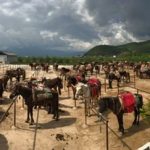We were welcomed into the home of Tsui Tsu and her Tibetan family for a wonderful homestay experience. The family were gracious hosts teaching us about their culture and inviting us to partake in a community rain prayer ceremony, which worked because it began to rain the next day. The home is situated beside the Napa grasslands and seasonal lake where yaks and horses graze. We toured the village, farmland, and nearby wildflower filled open spaces. We stayed here 2 nights and were fed traditional Tibetan meals. Breakfast consisted of yak butter tea, fried bread, barley balls, and yak cheese. Dinner was a Tibetan hot pot with pig skin and pig fat among other vegetables. In the evening we sang songs, talked, and did a little dancing. The students were challenged by the active rats inside the house at night and the limited bathroom facilities, which were in poor condition because Tibetans usually go outside into the forest for the bathroom. The family was also in the process of building a new home, so the students were able to see the unique nail-free architecture, mud walls, and hand carved wood work. The family had harvested, transported, carved and built the home all by themselves. They said it would take 3 more years to finish.






































































